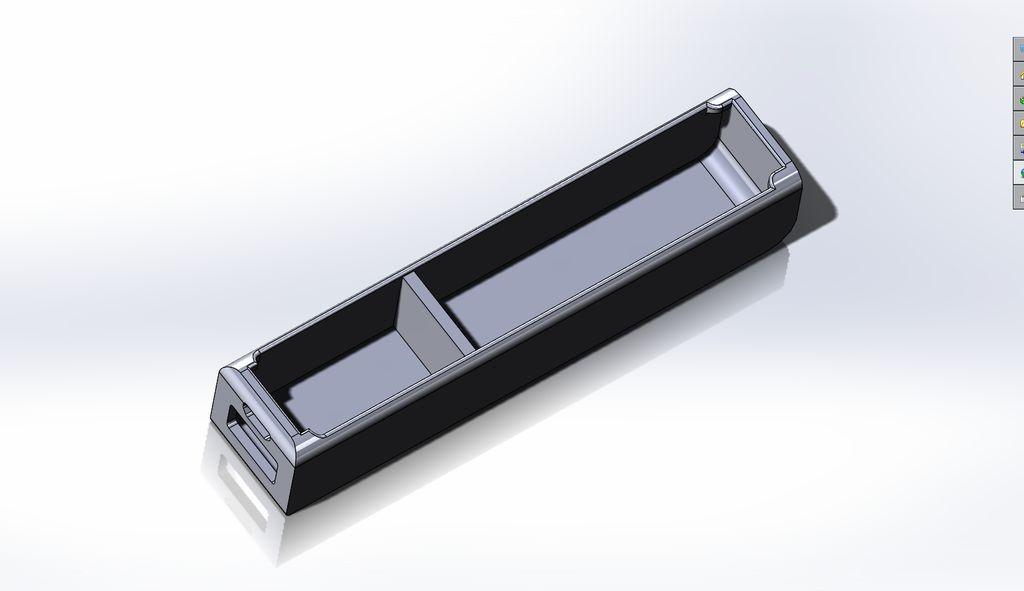These days, it really does seem that, for every problem, there’s a DIY approach–and thanks to the growing global community of makers, tinkerers, and problem solvers, there’s a 3D printed solution. Here’s one all the way from Istanbul, Turkey: A do-it-yourself, 3D printed cell phone charger. Sure, these devices are already on the market but if you can make your own and even improve on the standard model, then why not?
Instructables contributor Dr. Özkal Özsoy, who goes by “hobbyman,” agrees and so he set about creating a 3D printed, battery-powered phone charger that seems only to fall short in the aesthetics department–according to his girlfriend, anyway, to whom he gifted the device. He was a good man for the job, as we’ve seen from some of his other Instructables contributions, like his modular 3D printed robot and dummy security camera.
There’s nothing miraculous about these devices. They’re basically powerful batteries that simply need to be charged themselves ahead of time. Given that you’ve planned ahead at least that much, they can save you in those situations where you may be unable to plug your phone directly into an outlet for recharging or when you just plain forgot to charge your phone. It’s your back-up plan.
Özsoy purchased one such device from eBay and it was the envy of his girlfriend, so he decided that, rather than buying another one and waiting the nearly two months it could take to arrive in the mail, he’d figure out how to make one himself. He had batteries as well as the charging and USB power supply modules on hand, plus a 3D printer and the know-how, so he got to work.
He began the project by doing a market review, looking to see what was out there. He recalled, “There are many products of a similar kind on the market. On the internet you can find hundreds, maybe thousands of different kinds.” Mentally filing away their different characteristics, all of the pluses and minuses, he began sketching and quickly decided on a basic design, “a boxy, rectangular shape with rounded corners.” He also decided that his phone charger would have two main parts that would connect and lock into place, eliminating the need for screws.
Özsoy created a list of the electronics parts he used to construct the charger (he provides links to suggested products available through eBay on the Instructables page):
- Two rechargeable batteries
- Battery charging modules
- USB power regulator module
- A switch
- Battery contacts
The 3D modeling was accomplished using Solidworks. Before beginning, he did some sketching and thinking about how best to size and shape the case. Beginning with a basic rectangular prism, he worked through the steps, creating the internal details and eventually cutting the required components to create three parts: The upper body, the lower body, and the internal support. Finally, he added the internal details.
His STL files are available on the Instructables page. Özsoy used his UP 3D printer to produce the printed parts, which took about five hours and used around 40 grams of ABS filament. He used semi-transparent filament so that the LEDs on the electronic modules can be seen from the outside.
The results of Özsoy’s DIY, 3D printed phone charger project are pretty great, actually.
There are a couple of caveats, however: You need to be sure the device works properly before closing the case as the interlocking mechanism works so well it can be a little challenging to open the device again once it’s closed. Also, one commenter pointed out the the UltraFire batteries Özsoy used may not be the best choice, and that there are other 18650 ion batteries that may hold a charge longer, so you may want to do some research before installing the batteries.
Lastly, as mentioned above, when gifted with the great new device, Özsoy’s girlfriend found the appearance of the charger somewhat plain. She asked him to paint it and add a light.
“I plan to make an additional led light part which will be inserted to the usb port when necessary and I guess there is also a small paintjob is waiting in the near future,” he said. “Maybe I should leave the painting to her.”
Now the great little DIY device can multitask and it can look stylish while in use, although we imagine that, in that critical moment when you realize you’ve neglected to charge your phone the charger becomes an almost life-saving device, you won’t much care what color it is.
Is this charger something that would charge your creative batteries? Let us know if you’ll try out your own in the 3D Printed Cell Phone Charger forum thread over at 3DPB.com.
Subscribe to Our Email Newsletter
Stay up-to-date on all the latest news from the 3D printing industry and receive information and offers from third party vendors.
You May Also Like
Creality Begins Selling HALOT-MAGE S: Setting New Standards in Precision 3D Printing
Creality, a leading innovator in consumer-grade 3D printing technology, proudly introduces the HALOT-MAGE S, the latest breakthrough in high-resolution 3D printing. With its cutting-edge features and user-centric design, the HALOT-MAGE...
Farsoon Showcases Comprehensive 3D Printing Solutions, Automation, and More at TCT Asia
This year’s TCT Asia event showcased just how much the Asian additive manufacturing (AM) market has grown, with Eplus3D’s 64-laser metal 3D printer alone acting as a synecdoche for China’s...
Creality Launches Ender-3 V3 Plus: Bigger CoreXZ for Unprecedented Performance
Embracing a journey of innovation and excellence, Creality’s Ender-3 series has established a distinguished path in the field of 3D printing. From the entry-level Ender-3 V3 SE to the feature-rich...
Laser Wars: Eplus3D Unveils Metal 3D Printer with up to 64 Lasers
Now that the laser wars in the powder bed fusion (PBF) space have, for the most part, moved to China, original equipment manufacturers (OEMs) there are in fierce competition. Eplus3D...



































